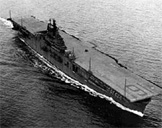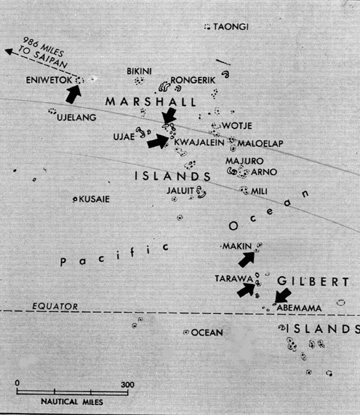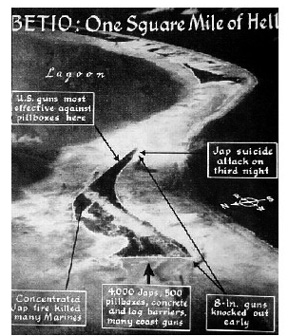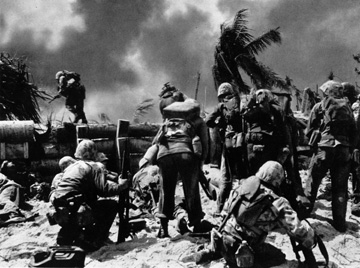|
Fred Gwynn's Editor’s Introduction |
||||||||||||||
 |
||||||||||||||
 |
||||||||||||||
|
this story into proper perspective. This information and the two related illustrations were taken from Life’s Picture History of World War II, a product of Time Inc., New York, 1950. The Attack on Tarawa: Early in the war the road to victory against Japan apparently lay along the Solomons-New Guinea axis through the southern Philippines, thence on to Singapore, Burma and China (which would furnish bases to bomb Japan out of the war.) The seizure of the Marshall Islands and Truk in the Carolines was scheduled, but its purpose was to tighten the communications line to Australia and break into Japan’s inner defense line. By the middle of 1943, however, it was obvious that Rabaul, which was holding up the New Guinea advance, was tougher than anybody had envisioned. The U.S. Joint Chiefs of Staff, to whom the Allies had delegated Pacific responsibility, gave top priority to a westward advance across the great ocean. As a preliminary Admiral Nimitz was instructed in July of 1943 to seize the Gilbert Islands, a string of coral atolls that lie across the equator some 2,200 miles southwest of Hawaii. |
||||||||||||||
| For Operation Galvanic, Nimitz asked General MacArthur to return the 1st Marine Division, which had been in Australia since Guadalcanal. But MacArthur planned to use the 1st to capture Rabaul, and he refused. Nimitz then decided to bring up the 2nd Marine Division from New Zealand and to employ elements of the 27th Infantry Division, than in training on Oahu. The soldiers were assigned the capture of lightly defended Makin Island. The marines drew Tarawa, an atoll whose main island, named Betio, was only one mile square. |
||||||||||||||
 |
||||||||||||||
|
D-day, Nov. 20, 1943. |
||||||||||||||
| Before the landing, the remarkable total of 3,000 tons of bombs and naval gunfire — surely enough to kill every living thing — was poured upon the little island. But Tarawa’s 4,836 defenders, dug in behind coconut-log pillboxes and concrete blockhouses (up to 96 inches thick), were undaunted. The first waves of marines wheeled through the water in new amphibian tractors Subsequent waves learned the water over the reef was too shallow; their Higgins boats could not get in.
The slow, half-mile trudge through the water began. |
||||||||||||||
 |
||||||||||||||
| Wading through murderous mortar and machine-gun fire, fortified only by a selfless devotion to duty and a sense of their own invincibility, the marines answered the call: “They need help bad on the beach.” For 30 hours men were mowed down by the dozens, but more came on. Such was the battle discipline in the reinforcing waves that no man was seen to turn back from what appeared to be certain extinction. |
||||||||||||||
 |
||||||||||||||
|
In the first central Pacific invasion Marines on Tarawa attack across a coconut-log sea wall against vicious Japanese Gunfire. |
||||||||||||||
| Once ashore, they piled over the sea wall with rifle, bayonet and flame thrower to weed out the determined defenders. After 76 hours it was over. The marines lost 990 killed, 2,296 wounded; but they dismissed forever the Japanese taunt that Americans were afraid to die. The Marshalls had been Japanese since they were grabbed from Germany in World War I — a seizure later sanctioned by League of Nations mandate. As a consequence of Tarawa, Navy tacticians at Pearl Harbor were fearful, and also split: some wanted to start at Juluit at the bottom of the chain and work up, but Nimitz voted with his chief planner Rear Admiral Forrest Sherman for plunging into the biggest and toughest of the atolls, Kwajalein. Assigned to the invasion were the Army’s veteran 7th Infantry Division, to attack the southern end of the 60-mile-long atoll, and the new 4th Marine Division, to capture the twin islands of Roi and Namur in the north. The landing (January 31, 1944) was preceded by a shelling from 50 warships and a bombing from the planes of 12 carriers plus aircraft based in the newly won Gilberts — total: 15,000 tons of hot steel. The new underwater demolition teams went in first to blow paths in the reefs and to clear beach obstacles. Artillery was set up on nearby small islands before the principal targets were assaulted. The Army introduced the wonderful amphibious truck, DUKW (duck). Thus the lessons of indispensable Tarawa, written in the blood of 3,000 marines, saved other thousands. Although those of the 8,500 Japanese who survived the gunfire fought to the death, Kwajalein Atoll cost the lives of only 356 soldiers and marines. Such success caused Rear Admiral Richmond Kelly Turner, the operations amphibious commander, to move on to Eniwetok, westernmost of the Marshalls, on February 17 — three months ahead of the Pacific timetable. Eniwetok’s 3,400 defenders were killed at a cost of 247 Americans. From the new Marshalls bases heavy bombers were soon bombing the Marianas to the west and Truk to the south.
End of Introduction, Page 2 — Go to Table of Contents you may go to Introduction — Table of Contents Chapter — 1 — 2 — 3 — 4 — Epilogue — or Go to the Lexington Stories Cover Page Or Home - Contact Us - Cold War Hist. - 91st SRS Hist. - Stardust 40 Mission Story |
||||||||||||||